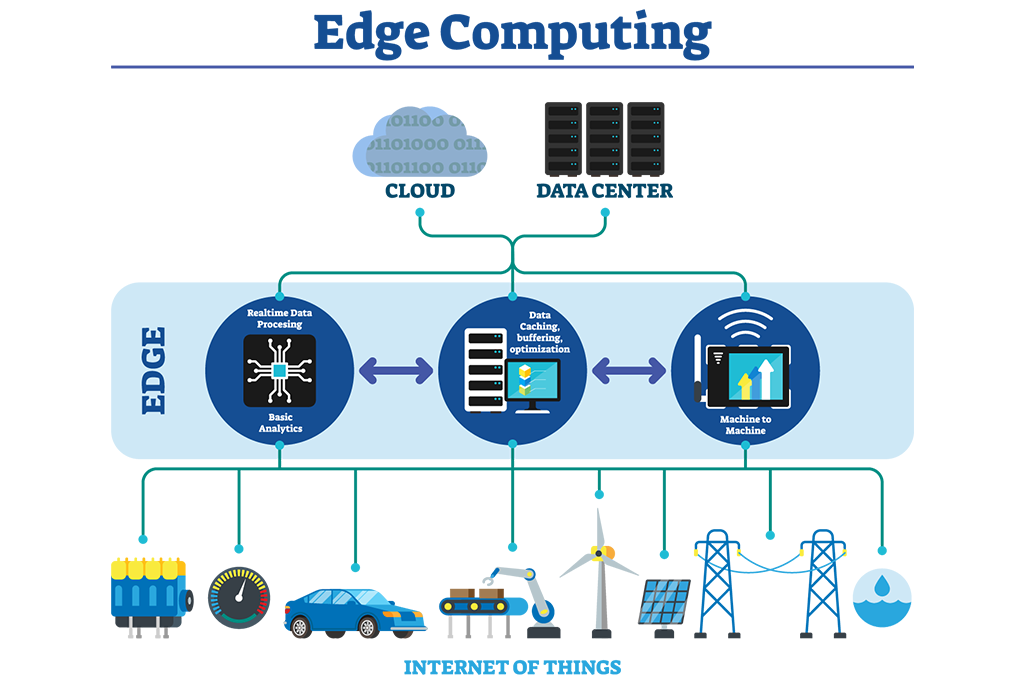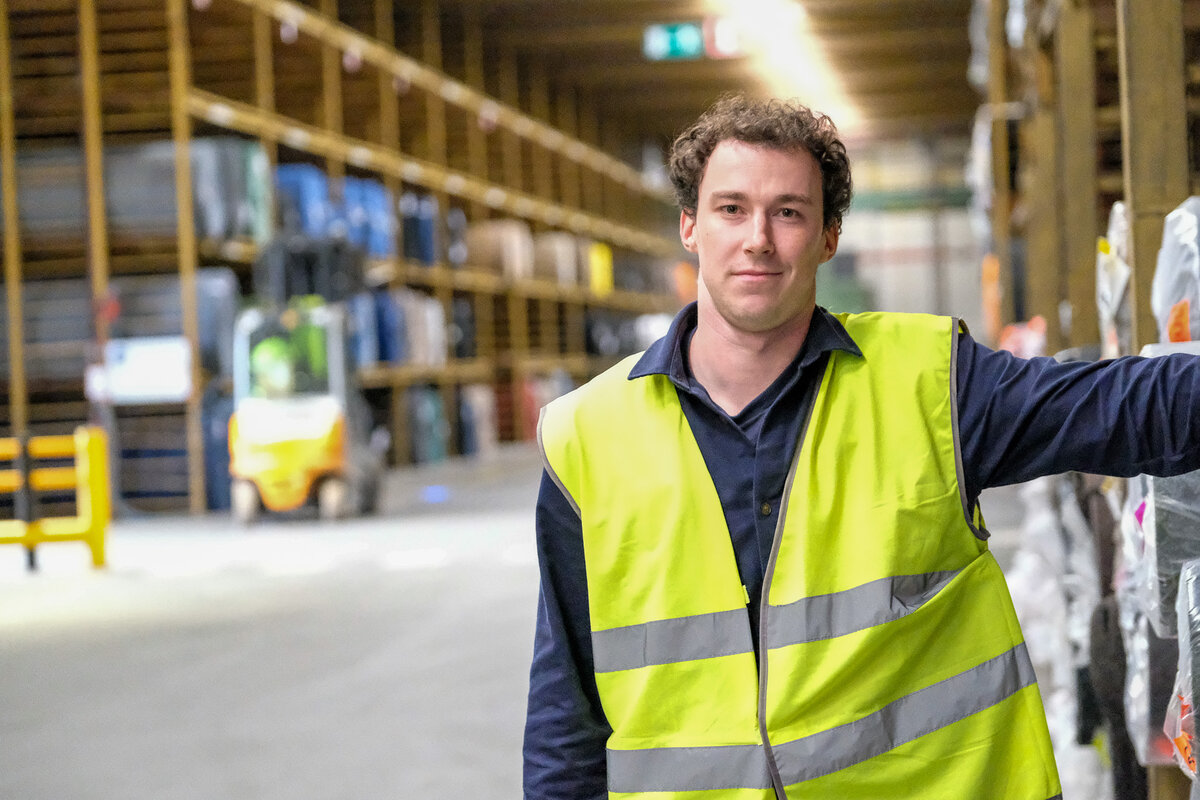In this series, we meet up with 10 inspiring B.I.G. experts. They each have a distinct vision of what tomorrow’s (business) world should look like. Normally, they prefer to stay behind the scenes. But for B.I.G. Talks, it’s all cards on the table. Korneel Verleden and Robbe Nuyttens team up to talk about Edge Computing.
“This isn’t the easiest of topics to translate for a big audience, is it?” Korneel Verleden, Project Engineer Automation, and Robbe Nuyttens, Automation Engineer, know that they are working on hard-to-understand projects within B.I.G.. However, what they do is crucial for everyone to make our machines run smoother and find solutions to problems in the present and future. Edge Computing isn’t the goal in itself, it’s more a means to an end, but one that will have lasting impact on the entire industry. Let’s dive in.
The working man’s cloud
Let’s begin with the question every person outside of an ICT-department will have when they first read about the topic: what is Edge Computing?
Robbe Nuyttens: “There are many ways that you can explain Edge Computing. You could look at it as a variant of Cloud Computing that gives you storage and computing power at a certain place in your network, for example next to your production machine . In this view, you could define it as a solution to decrease the amount of data being sent over the network. But you could also call it a way to empower engineers, operators and even machines to find solutions to manufacturing problems in real time. Either way, we see it as a toolbox that keeps on growing and helps us interpret data to make better decisions in every aspect of our manufacturing process.”
Korneel Verleden: “The biggest advantage is in the name itself: ‘Edge’. It brings calculating power to the edge of your network, in our case our machines. This makes it possible for people manning the machines to be informed more efficiently, so they can take action and responsibility in real time’. In the past, you would need to download the data from your operating software and process it centrally to find a fix to a problem with a machine. That takes time and a lot of manpower. The added value of Edge Computing is clearly in decreasing the time it takes to process an ever-growing stream of data from our machines.”
The technology is fairly new and rapidly developing. How did you go about introducing it in a group as big as ours?
Korneel Verleden: “We actually wanted to start working with Edge in 2019, but the software wasn’t mature enough then and shortly after, Covid made everything harder. However, we are one of the first to roll out the technology within our industry.” (Korneel and Robbe even gave a presentation at ABISS, a summit about digital, smart and connected industry, to share their insights about Edge Computing to industry leads last October, ed). “Many companies are investing in Edge Computing and are developing software as a service to help companies increase the efficiency of their machine park and production capacity. For us, it was important to get a digital native like Robbe on board. We already had extensive infrastructure that can give historical data and reporting, but with Edge and Robbe’s support, we wanted to go ‘In real time’. Since last year, we were able to really take that step. Getting everyone on board wasn’t always easy, because it demands a lot of involvement from a lot of people, but by explaining it as a solution instead of a new technology, we were able to create a real buy-in.”
Being a new technology, Edge Computing isn’t really something that you’re thought in school, is it?
Robbe Nuyttens: “No, we didn’t dive into “Edge” in my automatization training, but we did focus on software development and creating a vision on ICT and automatization. I’ve always been inspired to bring those two together and Edge was the answer to my questions.”

If we take a look at the production industry as a whole, only 27% of business have already begun implementing Edge Computing, while more than half of respondents in a Gartner report (an S&P 500 company providing insights to businesses worldwide) said they didn’t know enough about the technology to start working with it. Why is that?
Korneel Verleden: “Well, classic technology still offers a lot of solutions to current industry problems. Many people still have an old way of thinking about those problems. Yet, we truly believe Edge Computing will be the most dominant technology within automatization in 10 years. But the challenge is in introducing it successfully. You not only need to have young graduates who are capable of thinking in a new way, you also need to make sure you’re not implementing technology just for the sake of technology. It needs to serve a purpose.”
Robbe Nuyttens: “We’re still learning a lot. Going from testing out the technology to an industrial roll-out is a huge operation, even more in a company like ours. However, we’re tackling one project at a time, without a hard deadline for full penetration. This gives us the opportunity to learn from every use case, become faster and apply our learnings to each new project. One great example is the heatset machine, where we used Edge to find out how the machine works, which we can now use to partly rebuild the machine ourselves.”
What have been the main advantages for B.I.G. in adopting Edge Computing?
Robbe Nuyttens: “Edge Computing offers an enormous flexibility to conduct research about processes in our machine park. And the best thing is; Edge doesn’t have to be a permanent implementation. You can use it to solve a problem to break it down afterwards. The older ICT-software is still more than adequate for reporting.”
Korneel Verleden: “We’ve also profited from our close relationships with our machine suppliers, who help us standardize procedures based on Edge Computing as much as possible. Sharing information with other companies who are active in Edge Computing is a bit more difficult, because of the everchanging nature of the technology. New variables and parameters are constantly changing our way of working, even after we’ve implemented Edge Computing in a manufacturing process.”
Robbe Nuyttens: “One of the maybe surprising and positive consequences of Edge Computing is that we see an increase in self-reliance with the end-user in a manufacturing process (mostly the machine operator), while the machine operator gets so much flexibility to work with a machine. The data Edge Computing allows us to use is amazing, but if you don’t have people that can turn data into information, it isn’t worth anything.”

It's clear Edge Computing offers a lot to our efforts of automatization. But there must be a lot of challenges as well?
Robbe Nuyttens: “The biggest challenge is in cooperation. To make Edge Computing work, many divisions within a company need to work together. You need buy-in from top to bottom. Your ICT department, engineers and operators all need to be aligned in order for this to work. You can’t be working on your own anymore.”
Korneel Verleden: “Process knowledge, machine knowledge and network knowledge are as important as knowledge of Edge Computing. When these four meet, magic can happen.”
What does the future hold for Edge Computing in our industry?
Korneel Verleden: “There are so many possibilities. Edge Computing will help us to be more energy-efficient, to make better choices, to reduce bandwidth on our network – which is necessary when we keep on increasing the amount of data we’re generating – or to protect us from cyber-security threats. I compare it to the smartphone; the first generation of smartphones had apps like notepad or timer, but now we’re playing Augmented Reality games or analyzing the health of our plants on our device through sophisticated apps. The future of Edge Computing will be software-evolution-based. The apps will make the difference.”
Robbe Nuyttens: “Exactly! Edge Computing will have a key role in so many processes. Look at the link with Cloud Computing. The Edge Computer can analyze data and send through what’s important to the Cloud. There, heavy calculations like Artificial Intelligence (AI) can be done to calculate results that are sent back to the Edge. Or think about cyber-security; standardizing our machine park will allow us to deploy safety-updates much quicker and easier.”
We wouldn’t be B.I.G. if we didn’t focus on the sustainability question. Everyone at B.I.G. needs to do their part to help us shape sustainable living together. So, how can Edge Computing be used to improve sustainability?
Robbe Nuyttens: “Mainly by helping operators to handle their machines as energy-efficient as possible. This is something we can deploy to every machine we have. Next to that, some production processes we have can use recycled materials instead of virgin materials. This is where Edge Computing can make a real difference. You have to understand that recycled materials make your manufacturing process more difficult because it adds variance and unpredictability. If Edge Computing can help your machine to change its settings in real time, we can handle this unpredictability much better.”
Korneel Verleden: “Edge allows us not to be blind during production. And that has advantages beyond using more recycled materials as well. Think about manufacturing waste. Our yarn wrappers used to experience many malfunctions, causing a lot of broken threads and the subsequent waste. With Edge Computing, we discovered there was a frequency at which the wrappers were turning that caused the malfunctions. That knowledge alone has halved the amount of yarn waste we make from this process.
Triggered by Robbe and Korneel’s work on Edge Computing? Become part of our B.I.G. team and help us shape the future of sustainable living, together!